Grenoble, a dynamic city in southeastern France, is located in the Auvergne-Rhône-Alpes region and is surrounded by three majestic mountain ranges: the Chartreuse, the Vercors, and the Belledonne. Known as the "Capital of the Alps," Grenoble offers an extraordinary fusion of natural beauty, historical depth, and technological innovation. With a population of about 160,000 and a metropolitan area exceeding 450,000, the city thrives as both a cultural hotspot and a scientific hub.
Introduction to Grenoble – Capital of the Alps
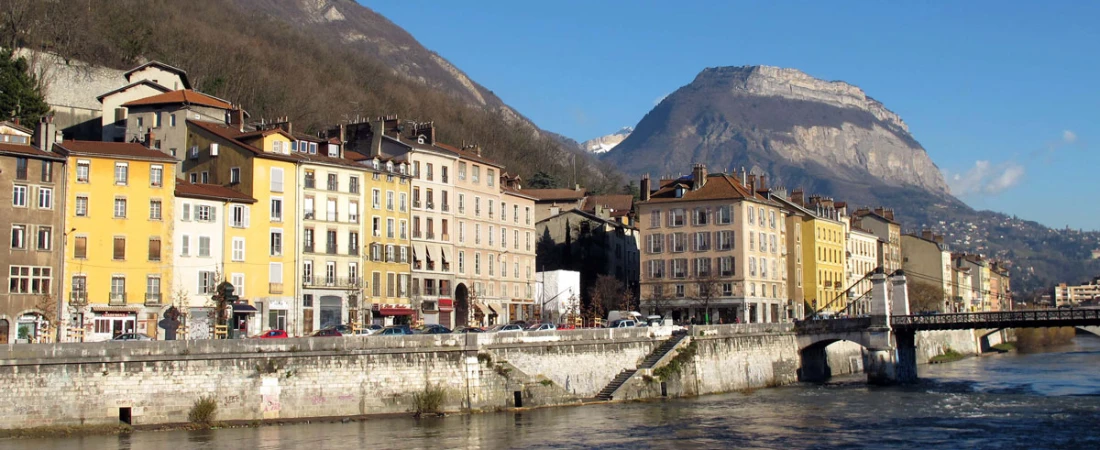
Where is Grenoble Located?
Grenoble lies at the foot of the French Alps, about 100 kilometers southeast of Lyon and 150 kilometers from Geneva. The Isère and Drac rivers converge here, adding to the city's charm. Its central location makes it a key gateway to some of France's most spectacular alpine scenery.
Why It's Called the “Capital of the Alps”
The moniker "Capital of the Alps" reflects not just Grenoble's geographic positioning but also its identity. It’s a base for countless outdoor adventures, ski resorts, and mountain activities. Its accessibility to the Alps makes it a popular destination for nature lovers and sports enthusiasts.
Grenoble's Historical Timeline
Grenoble’s origins date back over 2,000 years to Roman times when it was known as Cularo. Renamed Gratianopolis in the 4th century, it grew into a regional power. By the Middle Ages, it had become the capital of the Dauphiné region. The city's history includes significant contributions to the French Revolution and a pivotal role during WWII as a center of resistance.
Importance During WWII
Grenoble earned the title of "Compagnon de la Libération," one of the highest honors given by General Charles de Gaulle. The city was a major center of the French Resistance and endured significant Nazi retaliation. Museums like the Musée de la Résistance et de la Déportation help preserve and educate about this legacy.
Climate & Geography
Grenoble experiences a humid subtropical climate, with cold, snowy winters and hot, dry summers. Its unique geographic bowl results in frequent temperature inversions, causing fog and smog in colder months. Spring and autumn are considered the best seasons to visit due to milder weather and fewer crowds.
Urban Layout and River System
The city is structured around the Isère River, which divides the town and provides scenic riverside walks. Grenoble's urban layout combines modern planning with preserved medieval quarters, offering a harmonious blend of history and contemporary living.
Grenoble’s Role in Science and Innovation
Grenoble is a European leader in science and technology. It hosts over 60,000 students and is home to top-tier institutions like Université Grenoble Alpes and research centers such as the European Synchrotron Radiation Facility (ESRF) and the Institut Laue-Langevin (ILL). The city's tech scene is further supported by its thriving startup culture.
Student Life and International Community
Thanks to its universities and research institutions, Grenoble has a vibrant student population that brings international diversity. The city is welcoming to foreigners, with various student events, language exchanges, and multicultural festivals enriching the social scene.
Eco-conscious City Planning
Grenoble was named the European Green Capital for 2022 due to its ambitious sustainability efforts. These include expanding pedestrian zones, investing in clean public transport, promoting cycling, and preserving green spaces. It is considered a model for urban ecological transition.
What Makes Grenoble Unique?
What sets Grenoble apart is its incredible dual identity: a city that thrives on innovation while staying deeply connected to its natural surroundings. Whether you're hiking in the mountains, attending a scientific conference, or enjoying a street performance, you experience a city that embraces contrast—making it a uniquely inspiring travel destination.
Famous Landmarks and Attractions
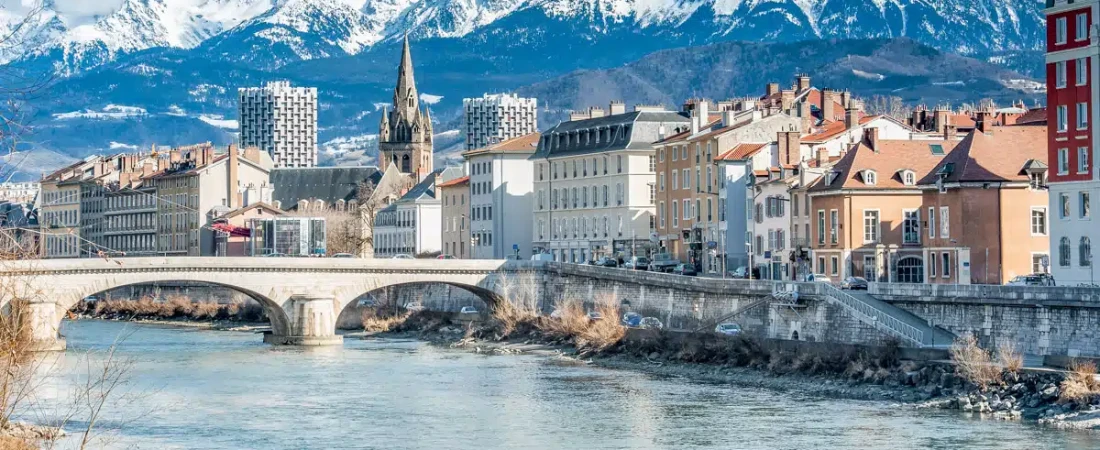
Grenoble is a city where history, art, and stunning views intersect. Each landmark in this alpine city tells a unique story, whether it's from ancient Roman times, the Enlightenment era, or modern scientific development. Here are ten must-see landmarks and attractions that showcase the spirit and identity of Grenoble.
Bastille Hill and Cable Cars
One of Grenoble's most iconic landmarks is the Bastille, a fortified hilltop site that dates back to the 16th century. Visitors can hike up or take the scenic cable cars known as "Les Bulles," which depart from Quai Stéphane Jay, 38000 Grenoble. The views from the top are breathtaking, offering a panoramic vista of the city and surrounding Alps. The Bastille also features hiking trails, cafes, and an underground military museum.
Musée de Grenoble
Located at 5 Place de Lavalette, 38000 Grenoble, this museum is one of France’s most respected art institutions. It houses works from ancient Egypt to the 21st century, including masterpieces by Picasso, Matisse, and Monet. The building itself is modern and airy, providing a serene environment to appreciate over 900 pieces of art.
Saint-Laurent Archaeological Museum
Situated in the historic Saint-Laurent neighborhood (Place Saint-Laurent, 38000 Grenoble), this museum is built over an ancient necropolis. It features underground crypts, tombs, and artifacts dating back to the 4th century. The lighting and layout make it an immersive experience.
Grenoble Cathedral
This Gothic-style cathedral is located at Place Lavalette, right beside the Musée de Grenoble. Though modest in appearance, it dates back to the 10th century and features stunning stained-glass windows, a grand pipe organ, and a peaceful atmosphere that invites reflection.
Place Grenette
As one of the oldest and most lively squares in Grenoble, Place Grenette is a hub of cafes, shops, and historic buildings. It’s the perfect place to sit back, have a coffee, and people-watch. The square is beautifully lit at night and often hosts open-air events.
Jardin de Ville
Nestled in the heart of the city, this elegant public garden offers a relaxing escape from the urban buzz. Located just off Place Saint-André, it features manicured lawns, fountains, and flower beds, and is adjacent to the beautiful Hotel de Lesdiguières, the former mayor’s residence.
Museum of the Resistance and Deportation
At 14 Rue Hébert, 38000 Grenoble, this poignant museum offers a deep dive into Grenoble’s critical role during World War II. Through photographs, documents, and artifacts, it tells the story of the local Resistance fighters and their heroic struggle against Nazi occupation.
Le Magasin – Centre National d’Art Contemporain
Located at 8 Esplanade Andry Farcy, this contemporary art space was once an industrial warehouse. Today, it hosts cutting-edge exhibitions from both French and international artists. The building’s industrial character provides a unique contrast to the modern works displayed inside.
Paul Mistral Park and Perret Tower
Paul Mistral Park (Boulevard Clémenceau) is Grenoble’s largest urban green space, ideal for walking, jogging, or family outings. Within the park is the Perret Tower, a 95-meter concrete observation tower built in 1925. While currently closed to the public, it's a significant architectural feature and symbol of modernity.
Fontaine du Lion and City Hall
Located in the Esplanade area near the Isère River, the Fontaine du Lion commemorates a battle between the lion (symbol of France) and a snake (representing the Isère). Nearby, Grenoble’s City Hall stands as a modernist landmark and an example of post-war French architecture.
Each of these sites is easily accessible and provides a deeper insight into the city’s multifaceted personality. From ancient crypts to cutting-edge art galleries, Grenoble invites exploration at every turn.
Natural Beauty & Outdoor Adventures
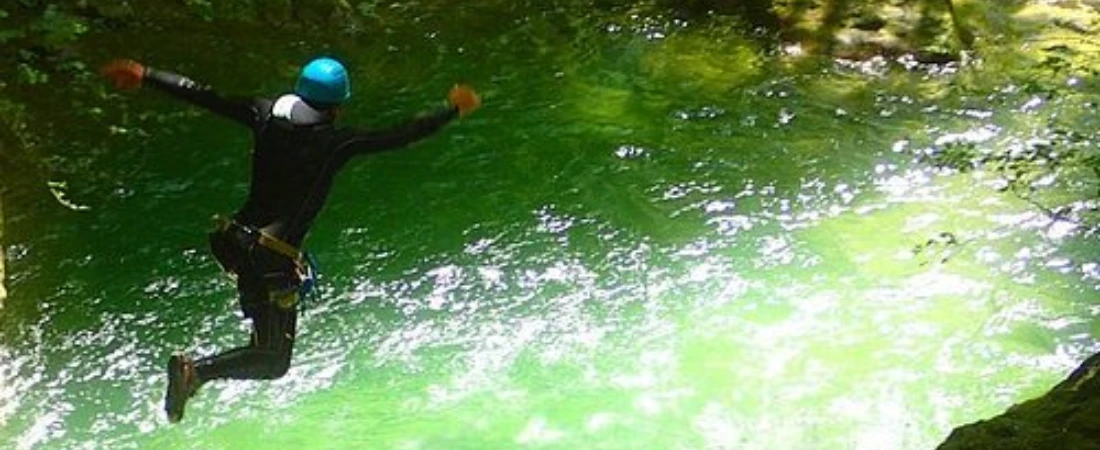
Grenoble is not just an urban center; it's a city seamlessly woven into the fabric of nature. Surrounded by mountains and rivers, the region offers countless opportunities for adventure and outdoor relaxation. Whether you're a seasoned hiker, a casual stroller, or a winter sports enthusiast, there's something for everyone just beyond the city limits.
Chartreuse Mountains
To the north of Grenoble lies the Chartreuse mountain range, a haven for hikers and nature lovers. The area features lush forests, limestone cliffs, and charming alpine villages. Top hikes include the trail to Charmant Som and the Monastère de la Grande Chartreuse, the spiritual heart of the region.
Vercors Regional Natural Park
Southwest of the city is the Vercors Plateau, known for its dramatic cliffs, deep gorges, and karst landscapes. Hiking, rock climbing, and even spelunking are popular here. The village of Villard-de-Lans is a good base for exploring this wild and picturesque area.
Belledonne Range
To the east, the Belledonne mountains offer more rugged and high-altitude terrain. This is the place for more experienced mountaineers, with trails leading to glacial lakes and panoramic viewpoints. Winter months bring excellent skiing and snowshoeing opportunities.
Isère River Walks
The Isère River flows through the heart of Grenoble and is flanked by scenic walking and cycling paths. The Promenade de l’Isère offers peaceful riverside views, perfect for an afternoon stroll or morning jog.
Hiking Trails Near the City
Grenoble’s unique location means that even public transportation can take you to a trailhead. Hike from La Tronche or Seyssinet-Pariset to reach scenic lookouts over the city. The Chemin de la Bastille, while urban, offers a rewarding climb.
Mountain Biking Spots
Mountain biking is extremely popular around Grenoble, especially in the Chartreuse and Vercors areas. Local rental shops and clubs can help you get started. Downhill and cross-country trails are well-marked and cater to all skill levels.
Ski Resorts Near Grenoble
Grenoble serves as a gateway to several ski resorts within an hour’s drive. Chamrousse, located 30 km away, is a family-friendly resort with slopes for all levels. Les 7 Laux and Villard-de-Lans are other excellent choices, offering a variety of runs and off-piste areas.
Paragliding and Aerial Views
For those seeking a bird's-eye view of the Alps, paragliding is available in areas like Saint-Hilaire-du-Touvet. Tandem flights are popular and require no experience. You’ll glide over forested valleys and catch unparalleled views of the surrounding peaks.
Kayaking and Paddleboarding
During the warmer months, the nearby lakes and calm sections of the Isère River are great for kayaking, canoeing, and paddleboarding. Lac du Bois Français is a popular spot, located just a short drive from the city.
Best Picnic Spots
Pack a lunch and enjoy a picnic at one of Grenoble's many scenic spots. Top locations include Bastille Hill, the banks of the Isère, and Paul Mistral Park. These areas offer stunning views and a peaceful atmosphere for a relaxing outdoor meal.
Grenoble’s natural offerings are not just an accessory to city life—they are integral to its identity. With so much adventure at your doorstep, it's easy to see why outdoor living is part of the local lifestyle.
Culture, Arts, and History
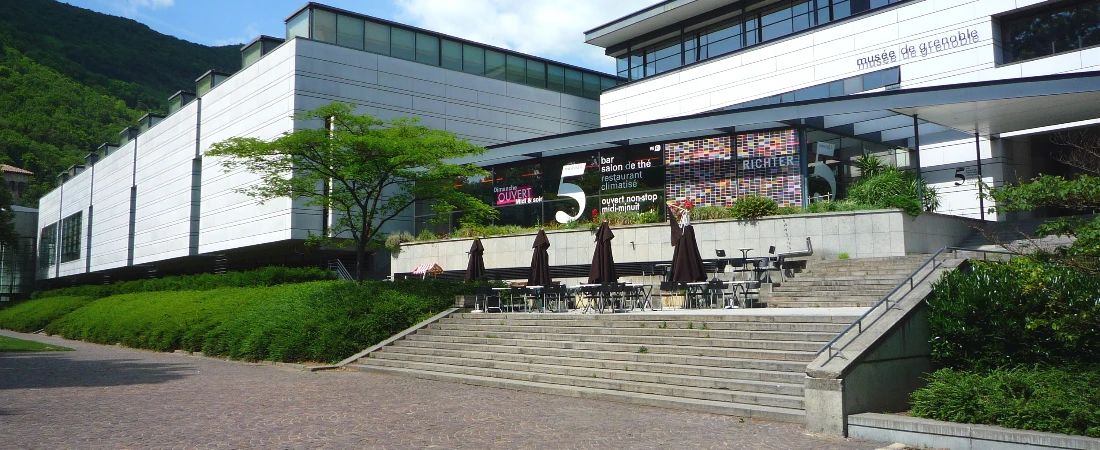
Grenoble offers a rich cultural tapestry that reflects both its alpine heritage and its status as a modern intellectual hub. From ancient ruins to contemporary art, and from scientific innovation to vibrant street life, the city celebrates its multifaceted identity through countless cultural experiences.
Traditional Alpine Culture
Grenoble’s traditions are deeply rooted in its mountainous setting. Folk music, alpine crafts, and culinary customs such as cheese-making and walnut harvesting are still celebrated in local festivals and markets. The city’s connection to the surrounding rural communities has preserved these traditions for generations.
Street Art in Grenoble
Street art thrives across Grenoble’s neighborhoods. Initiatives like the Grenoble Street Art Fest have turned entire buildings into colorful canvases. Areas such as Quartier Championnet and the Presqu’île district feature massive murals and graffiti created by both local and international artists.
Art Galleries and Exhibitions
Aside from the renowned Musée de Grenoble, the city boasts numerous smaller galleries like the Galerie Vent des Cimes (25 Avenue Alsace Lorraine), specializing in contemporary works. Exhibitions range from classical to avant-garde, providing platforms for emerging and established artists alike.
Music and Film Festivals
Grenoble is home to various annual cultural festivals. Cabaret Frappé is a summer music festival held in Jardin de Ville, showcasing diverse genres. The Grenoble International Short Film Festival attracts filmmakers and cinephiles from around the world, emphasizing creativity and experimentation.
Performing Arts and Theatres
The city supports a vibrant performing arts scene. La Belle Électrique (12 Esplanade Andry Farcy) is a popular venue for live music. Théâtre Municipal de Grenoble and MC2: Maison de la Culture host a wide range of performances, including ballet, opera, and modern drama.
Historic Architecture
Walking through the Old Town, you’ll find medieval buildings, Renaissance façades, and neoclassical architecture. Highlights include the former Parlement du Dauphiné, the Place Saint-André, and the Hôtel de Lesdiguières, which reflects the city’s political and cultural significance during the Ancien Régime.
Religious Sites
Grenoble’s religious heritage is visible in its diverse places of worship. Besides the Grenoble Cathedral, notable sites include the 13th-century Saint-Louis Church and several chapels that dot the surrounding countryside. These spaces often host concerts, exhibitions, and community gatherings.
Local Legends and Folklore
Folklore adds charm to Grenoble’s historical fabric. Tales of hidden underground tunnels, the mysterious creature of the Chartreuse forests, and the symbolic Lion Fountain reflect the blend of myth and history that locals embrace and celebrate.
Influence of Science on Culture
Grenoble’s scientific achievements influence its cultural life. Institutions like MINATEC and CEA-Grenoble organize public exhibitions and workshops that bridge the gap between research and community engagement. Science museums and open labs are popular educational destinations.
Public Libraries and Learning Centers
The Bibliothèque Municipale de Grenoble and associated libraries host cultural events, readings, and art exhibits. Spaces like Le Ciel and the Maison de l’International foster intellectual exchange and promote Grenoble’s global outlook.
From its deep historical roots to its cutting-edge contemporary expressions, Grenoble offers visitors a full cultural immersion that mirrors its dual identity: steeped in tradition yet embracing the future.
Local Food and Culinary Delights

Grenoble’s cuisine is a flavorful reflection of its alpine roots, showcasing hearty dishes, rich cheeses, and ingredients sourced from the nearby mountains and valleys. Whether you're dining at a gourmet restaurant or browsing a farmers’ market, the local food scene is sure to delight every palate.
What is Gratin Dauphinois?
Gratin Dauphinois is Grenoble’s signature dish—thinly sliced potatoes baked in cream, garlic, and sometimes cheese. This comforting recipe originated in the Dauphiné region and is a staple in local homes and traditional restaurants.
The Cheese Culture (Tomme, Raclette, Bleu du Vercors)
Cheese plays a central role in local cuisine. Try Tomme de Savoie, Raclette (melted over potatoes and meats), and Bleu du Vercors-Sassenage, a creamy blue cheese with AOP status. These cheeses are best sampled in mountain chalets or at the covered market.
Walnut-Based Recipes
Grenoble is France’s walnut capital. You’ll find walnuts in everything from savory tarts to sweet pastries and oils. A must-try is the tarte aux noix (walnut tart), available in bakeries throughout the city.
Local Delicacies & Alpine Dishes
Besides gratin and cheese, other specialties include diots (savory sausages), crozets (small buckwheat pasta), and farçon, a sweet-savory potato cake. These dishes are especially popular in colder months when hearty meals are most appreciated.
Street Food in Grenoble
Grenoble’s vibrant student population has given rise to a diverse street food scene. Crêpes, falafel, kebabs, and paninis are widely available. Food trucks often appear near university areas like Domaine Universitaire or Place Notre-Dame.
Farmer’s Markets (Marché de l’Estacade)
Visit Marché de l’Estacade (Rue Nicolas Chorier) for a taste of local life. This daily market offers fresh produce, artisanal cheeses, charcuterie, honey, and seasonal specialties like mushrooms and chestnuts.
Regional Beverages (Walnut Liqueur, Wine)
No culinary tour is complete without sampling walnut liqueur, a local specialty made from green walnuts. You’ll also find regional wines from nearby vineyards in Isère and Savoie. For non-alcoholic options, try fresh alpine herbal teas.
Vegetarian & Vegan Options
Vegetarians will appreciate dishes like gratins, soups, and vegetable tarts. Vegan-friendly cafes and restaurants are growing in number, especially in neighborhoods like Championnet and around the train station.
Cafés and Tea Houses
Grenoble is dotted with cozy cafés and salons de thé where you can enjoy coffee, hot chocolate, or herbal infusions. Popular spots include Café de la Table Ronde (Place Saint-André) and Kaïra Café for a modern vibe.
Must-Try Desserts
End your meal with regional sweets such as tarte aux noix, chartreuse-infused pastries, or bugnes (alpine doughnuts). Local patisseries often experiment with walnuts and mountain herbs for unique flavor profiles.
Grenoble’s culinary scene combines the heartiness of mountain fare with the innovation of a youthful, multicultural city. Eating your way through the city is not just a delight—it’s a cultural experience.
Best Restaurants and Dining Spots
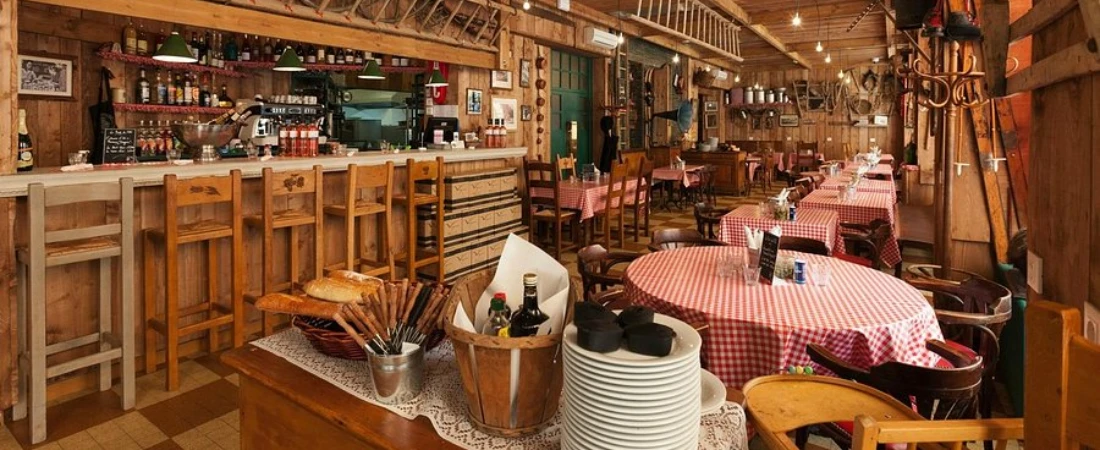
Whether you're after traditional Dauphinois cuisine or globally inspired fare, Grenoble’s restaurant scene offers something for every appetite. From elegant fine dining to cozy alpine taverns and trendy student cafés, the city is packed with culinary gems.
La Ferme à Dédé
Located at 5 Rue Barnave, this restaurant is a Grenoble institution known for its rustic mountain décor and hearty local dishes. Don’t miss their gratin dauphinois, fondue, and tartiflette. Portions are generous, and the ambiance evokes a traditional alpine farmhouse.
Restaurant L’Escalier
Tucked away at 7 Rue Brocherie, L’Escalier serves refined French cuisine with a creative twist. Their seasonal tasting menus include expertly plated dishes featuring fresh, local ingredients. Ideal for a romantic evening or special occasion.
Café de la Table Ronde
At 7 Place Saint-André, this is one of France’s oldest cafés, dating back to 1739. It serves brasserie-style meals in a warm and historic setting. Try the duck confit or beef tartare with a glass of local wine.
Le Fantin Latour
Found at 1 Rue Général de Beylié, this Michelin-starred restaurant delivers gourmet French dining in a stylish, modern environment. Chef Stéphane Froidevaux crafts intricate dishes inspired by the mountains and seasonal produce. Reservations are recommended.
Auberge Napoléon
Located at 7 Rue Montorge, this charming restaurant offers classic alpine fare in a Napoleon-themed setting. Known for its raclette, escargots, and exceptional service, it's a great spot for experiencing traditional French hospitality.
Vegan and Halal-Friendly Restaurants
Grenoble caters to diverse dietary preferences. Le Cœur à l’Ouvrage (11 Rue du Palais) is a popular vegan café with organic, homemade meals. For halal dining, Le Marrakech (19 Rue Nicolas Chorier) serves delicious Moroccan cuisine in a vibrant setting.
Fine Dining in Grenoble
In addition to Le Fantin Latour, Grenoble has several other upscale options. Le Casanova (14 Rue de la République) specializes in French-Italian fusion, while L’Amphitryon (31 Rue Servan) offers exquisite menus in a sophisticated dining room.
Budget Eats and Bistros
For quick and tasty meals, try Le Casse-Croûte à Dédé or Chez Mémé Paulette, where you’ll find local specialties at affordable prices. Many student-friendly bistros also line Rue Thiers and Rue Jean-Jaurès.
Outdoor Terraces with Views
Grenoble’s many squares and pedestrian zones offer restaurants with scenic terraces. L’Auguste (10 Place Victor Hugo) and Brasserie du Jardin de Ville both provide excellent outdoor seating—perfect for a relaxed lunch in the sun.
Where Locals Eat
Locals often flock to neighborhood favorites like Le Montagnard (8 Rue Saint-Jacques) for raclette or Le Petit Vatel (25 Rue Guetal) for fresh daily specials. These spots are less touristy but full of authentic charm.
From rustic comfort food to avant-garde cuisine, Grenoble’s diverse dining scene showcases the best of French gastronomy with a distinctive alpine flair. Be sure to reserve in advance during weekends and holidays, especially at popular spots.
Nightlife and Entertainment
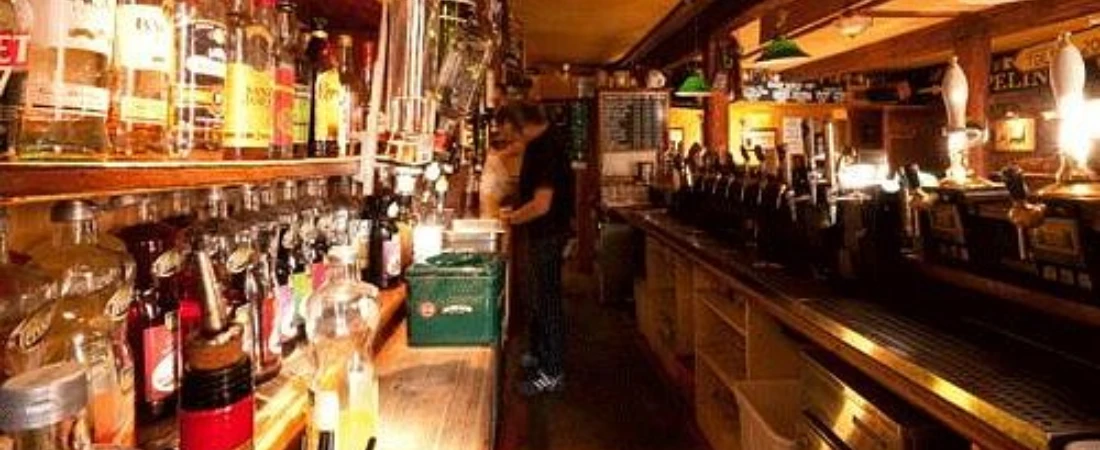
Grenoble’s nightlife reflects the city’s energetic student population and love for culture and connection. From buzzing pubs and cozy taverns to live music venues and cultural events, the city offers something for every mood and taste.
Pub O’Callaghan
Located at 2 Rue Gabriel Péri, this Irish pub is a favorite among students and expats. Known for its laid-back vibe, live sports screenings, and a wide selection of beers, it’s a great spot to kick off a night out.
Le London Pub
Situated at 2 Place Championnet, this British-style bar offers darts, quiz nights, and affordable drinks. It’s a popular gathering point for English-speaking locals and international students.
La Bobine
Found inside Parc Paul Mistral (42 Boulevard Clemenceau), La Bobine is a hybrid cultural space featuring concerts, art exhibits, and DJ nights. The outdoor terrace is lively in summer, while the indoor stage hosts indie bands and slam poetry.
Le Tord Boyaux
At 16 Rue Lakanal, this tiny and quirky bar is known for its infused liquors and funky decor. It’s a hidden gem that attracts a young crowd with its character and fun ambiance.
Bar Au Rêve
Located at 4 Rue de Strasbourg, Bar Au Rêve is a cozy café-bar ideal for relaxed evenings. It serves local beers and often features live acoustic music or board game nights.
La Belle Électrique
A major concert venue located at 12 Esplanade Andry Farcy, La Belle Électrique brings in national and international acts. The lineup includes electronic music, hip-hop, indie rock, and more. It also houses a trendy bar and restaurant.
Théâtre Sainte-Marie-d’en-Bas
This venue at 38 Rue Très-Cloîtres offers nighttime performances ranging from contemporary plays to improv comedy. It’s a great cultural alternative to bars and clubs.
Le Mark XIII
Located at 7 Rue Servan, Le Mark XIII is a stylish cocktail bar and music lounge offering DJ sets and occasional themed parties. It’s known for its extensive drink menu and chic interior.
Brasserie Artisanale du Dauphiné
At 6 Rue Abbé Grégoire, this microbrewery bar offers locally brewed beers in a rustic setting. They often host tasting nights and informal music sessions.
Café des Arts
Found at 36 Rue Saint-Laurent, this artistic café transitions into a vibrant social space in the evenings, hosting jazz nights, open mic sessions, and philosophy cafés. It's perfect for a quieter, culturally rich night out.
Whether you’re dancing to electronic beats, sipping cocktails with friends, or enjoying a thought-provoking performance, Grenoble's nightlife offers a range of experiences for every kind of traveler.
Getting Around Grenoble
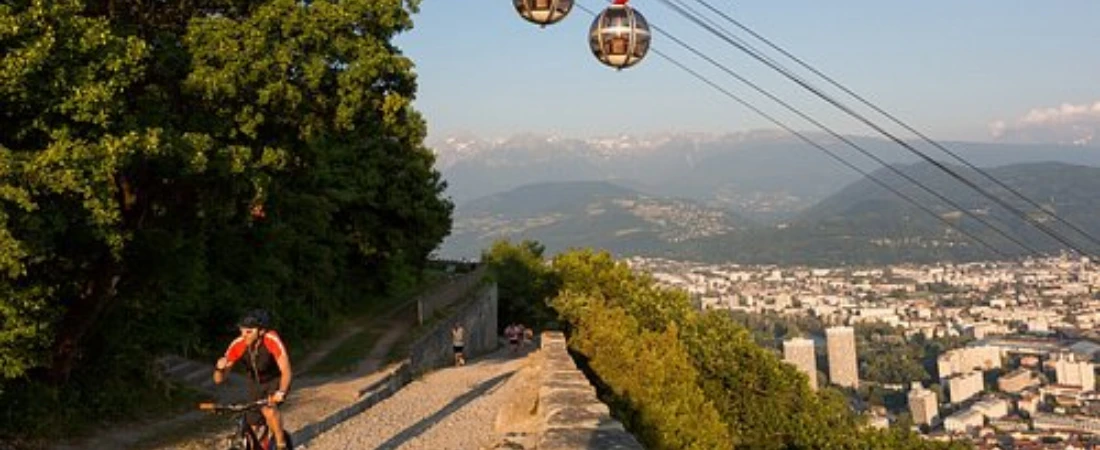
Grenoble’s compact size and excellent transport infrastructure make getting around the city efficient and affordable. Whether you prefer public transportation, cycling, walking, or driving, the city offers multiple options to suit your travel style.
Grenoble’s Public Transportation System (TAG)
Grenoble’s public transport network is run by TAG (Transports de l’Agglomération Grenobloise). It includes trams, buses, and night services. Tickets can be purchased at vending machines near tram stops or via the TAG app. Headquarters: 3 Rue de la Poterne, 38000 Grenoble.
Tram Lines and Major Stops
The tram system includes 5 main lines (A to E) covering the city and nearby suburbs. Key stations include:
- Gare de Grenoble (Main train station)
- Victor Hugo (for shopping and dining)
- Grand’Place (for mall access)
- Place Notre-Dame (historic center)
Bus Lines and Accessibility
Complementing the tram lines, buses connect more remote areas and operate from early morning until late night. Lines 16, 13, and C5 are especially useful for tourists.
Bicycle Rentals and Green Travel
Grenoble is one of France’s most bike-friendly cities. Métrovélo is the official bike-sharing service, offering short-term and long-term rentals. Main office: 1 Rue du Vieux Temple, 38000 Grenoble. Dedicated cycling lanes and flat city terrain make it easy to ride.
Walking Around Grenoble
Most of central Grenoble is walkable, with pedestrian-only streets in the Old Town and Championnet districts. Enjoy car-free exploration in areas like Place Saint-André, Rue Très-Cloîtres, and the Jardin de Ville.
Taxis and Ride-Sharing
Taxis can be booked via Taxi Radio Grenoble (+33 4 76 54 42 54) or through the app Allo Taxi. Ride-sharing services like Uber also operate in the city, though availability may vary at night.
Train Travel (SNCF Station)
The main SNCF train station (1 Place de la Gare) connects Grenoble to Lyon, Paris, and Geneva via high-speed TGV and regional TER trains. It’s also the hub for airport shuttles and regional buses.
Car Rentals and Driving
Car rentals are available near the train station, including agencies like Hertz, Europcar, and Avis. Address: 22 Avenue Félix Viallet, 38000 Grenoble. Parking garages are scattered throughout the city, with the Philippeville (2 Place de Metz) being central.
Airport Transfers
Grenoble Alpes-Isère Airport (Domaine de Saint-Étienne-de-Saint-Geoirs, 38590 Saint-Étienne-de-Saint-Geoirs) is 40 km from the city. Airport shuttle buses depart from the train station and take about 45 minutes.
Accessibility for People with Reduced Mobility
Grenoble offers excellent accessibility. Trams and most buses are wheelchair-friendly, and sidewalks are equipped with ramps. The city’s tourist office (14 Rue de la République) provides information on accessible routes and facilities.
Navigating Grenoble is easy thanks to its efficient transport options, walkable layout, and green initiatives. Whether you're traveling by tram or on foot, getting around is a smooth part of the Grenoble experience.
Best Time to Visit Grenoble
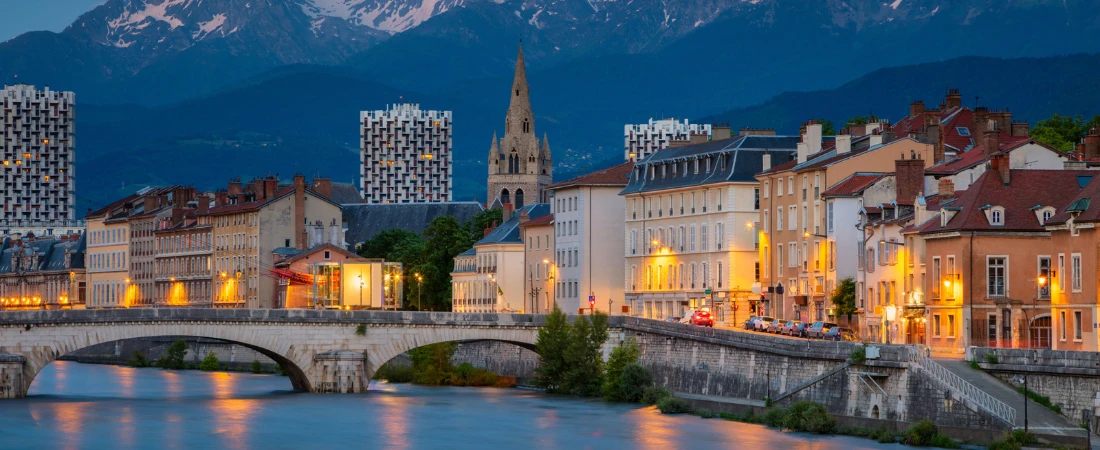
Grenoble is a year-round destination, with each season offering a unique experience. From winter sports to summer festivals, the city’s calendar is full of opportunities for travelers to explore and enjoy.
Winter (December to February)
Winter is ideal for skiing and snowboarding. The surrounding resorts like Chamrousse (Le Recoin, 38410 Chamrousse) and Les 7 Laux (Prapoutel, 38190 Les Adrets) are just 30–60 minutes from Grenoble and offer fantastic alpine conditions. Grenoble also lights up with festive markets, especially at Place Victor Hugo and Place Grenette.
Spring (March to May)
Spring brings blossoming gardens and milder weather, perfect for river walks and city exploration. Parc Paul Mistral (Boulevard Clemenceau, 38100 Grenoble) and Jardin des Plantes (31 Rue Dolomieu) come alive with flowers and picnickers. Fewer crowds make this season great for museum visits and hiking lower trails.
Summer (June to August)
Summer is festival season. Enjoy open-air events like Cabaret Frappé (Jardin de Ville, 38000 Grenoble) and the Grenoble Street Art Fest. The weather is hot but not extreme, averaging 28°C (82°F), making it perfect for hiking, mountain biking, and paragliding. Visit Lac du Bois Français (Route de Revel, 38420 Le Versoud) for swimming and sunbathing.
Autumn (September to November)
Fall is a scenic time to visit, with golden forests and harvest season in full swing. The walnut harvest around Vinay (20 km west of Grenoble) is a cultural highlight. The moderate climate is perfect for wine tasting, walks through Parc de l’Ile d’Amour (Chemin de l'Île d'Amour, Meylan), and local food festivals.
Events and Festivals Calendar
- Grenoble Jazz Festival (March): Held in multiple venues including MC2 (4 Rue Paul Claudel)
- Fête de la Musique (June 21): Free concerts citywide
- European Heritage Days (September): Free entry to landmarks like Musée de Grenoble (5 Place de Lavalette)
When to Avoid Crowds
January and February can get busy due to ski season. Late August is quieter when locals are on vacation. For relaxed travel, visit mid-April to early June or mid-September to October.
Best Season for Outdoor Activities
Summer and early autumn are perfect for outdoor sports. Spring is better for mild hikes, while winter is best for snow lovers.
Travel Tips by Season
In winter, dress in layers and bring waterproof gear. In summer, pack sunscreen and water bottles for hikes. Spring and autumn require comfortable walking shoes and a light jacket.
Accommodation Rates by Season
Hotel prices rise during ski season (December to February) and summer festivals. Budget-friendly stays are more common in spring and autumn.
Climate Overview
Grenoble has a humid continental climate. Expect hot summers, chilly winters with snowfall, and mild transitional seasons. Always check the forecast on arrival for best planning.
No matter the season, Grenoble offers a memorable experience. Time your visit according to your interests—snow, sun, or scenery—and you’ll find the city full of life.
Shopping in Grenoble
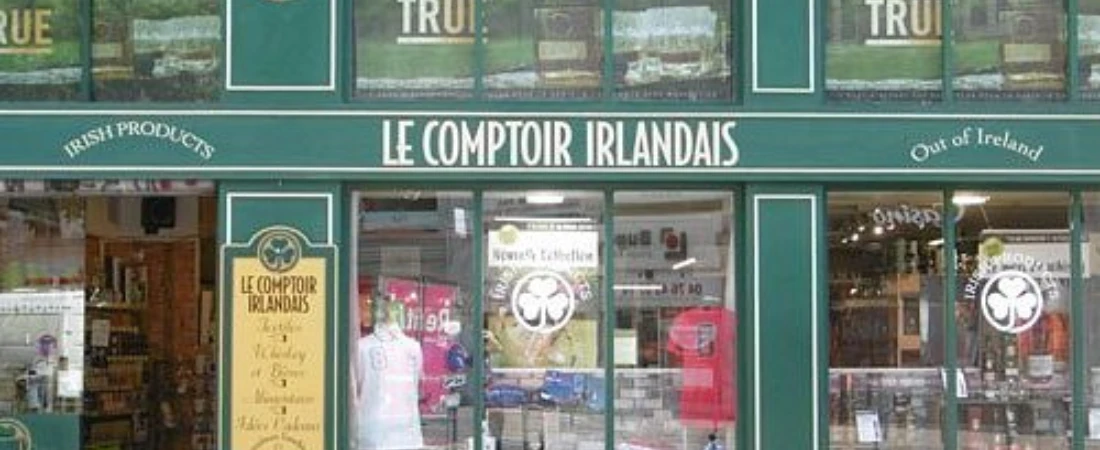
Shopping in Grenoble is a unique experience that combines alpine craftsmanship, gourmet delicacies, fashionable boutiques, and modern shopping centers. Whether you’re looking for outdoor gear, souvenirs, or regional specialties, Grenoble delivers an eclectic retail landscape.
Rue de Bonne and Grand’Rue
Rue de Bonne is Grenoble’s premier shopping boulevard, lined with stylish boutiques, high-street brands, and chic cafés. Nearby Grand’Rue in the historic center offers a mix of local artisan shops and trendy fashion stores within a pedestrian-friendly zone.
Artisanal Souvenir Shops
Head to Quartier Saint-Laurent or Rue Jean-Jaurès to find souvenir shops selling handcrafted items such as wooden carvings, soaps made with alpine herbs, and locally made jewelry. These make excellent gifts or keepsakes from your trip.
Walnut Products and Local Crafts
As the walnut capital of France, Grenoble is the best place to buy walnut oil, preserves, and liqueur. Visit specialty stores or markets to sample and purchase these gourmet treats. Try Maison de la Noix (10 Rue Ampère, 38600 Fontaine) for walnut-based gifts.
Fashion Boutiques and Designer Stores
From elegant French labels to edgy urban wear, Grenoble’s independent boutiques offer quality fashion. Check out L’Appartement (8 Rue Lafayette) or Anaïs & Pedro (5 Rue de Strasbourg) for curated collections.
Outdoor and Ski Gear Stores
Grenoble is a hub for outdoor enthusiasts. Find premium gear at Patagonia (9 Rue Montorge), Snowleader (5 Rue du Phalanstère), and local brands like Eider and Millet. Go Sport Montagne (4 Rue Docteur Mazet) also offers equipment and clothing.
Weekly Markets to Visit
Don’t miss Marché de l’Estacade (Rue Nicolas Chorier) and Marché de Sainte-Claire (Place Sainte-Claire) for fresh produce, cheese, baked goods, and handcrafted items. These lively markets provide a glimpse into local life and seasonal ingredients.
Local Bookstores
Explore Grenoble’s literary scene at Arthaud (23 Grande Rue), a historic bookstore with French and English titles. For secondhand finds, visit Librairie La Bouquinerie (17 Rue Bayard) or independent bookshops throughout the city.
Christmas Market Shopping
During December, Place Victor Hugo and Place Grenette transform into festive markets selling handcrafted ornaments, mulled wine, alpine goods, and regional treats. It’s an ideal time for atmospheric shopping.
Eco-Friendly and Sustainable Shops
Grenoble embraces eco-conscious shopping with stores like Day by Day (13 Rue Lafayette) and Ethic & Troc (9 Rue Condorcet), a second-hand and upcycled boutique. You’ll find sustainable fashion and packaging-free products.
Shopping Malls and Centers
For one-stop convenience, head to Centre Commercial Grand’Place (55 Grand’Place), which houses over 120 shops and restaurants. Caserne de Bonne (Boulevard Gambetta) is another popular open-air shopping complex known for its sustainable design and green certification.
From rustic market stalls to high-end fashion outlets, shopping in Grenoble is as diverse as the city itself. Take your time exploring its mix of old-world charm and modern convenience.
Final Thoughts
Grenoble isn’t just the Capital of the Alps—it’s a vibrant, innovative, and culturally rich destination that seamlessly blends nature and city life. Whether you’re drawn by the majestic mountain landscapes, the deep-rooted history, world-class museums, or the energy of a youthful university town, Grenoble has something for every traveler.
This city invites you to ride cable cars to ancient fortresses, taste creamy gratin dauphinois and mountain cheeses, browse quaint bookshops and artisanal markets, and dance the night away in an alpine tavern or music lounge. It’s a place where old-world charm meets scientific progress, where cobbled streets lead to cutting-edge art spaces and eco-friendly boutiques.
Accessible, welcoming, and endlessly scenic, Grenoble is a destination you won’t just visit—you’ll remember. Whether you’re here for a short trip or an extended stay, Grenoble promises experiences that nourish the soul, excite the senses, and expand your horizons.



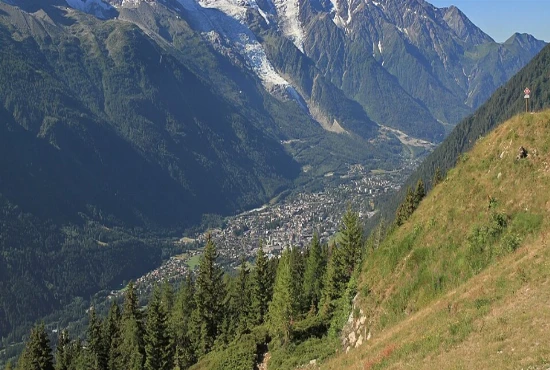
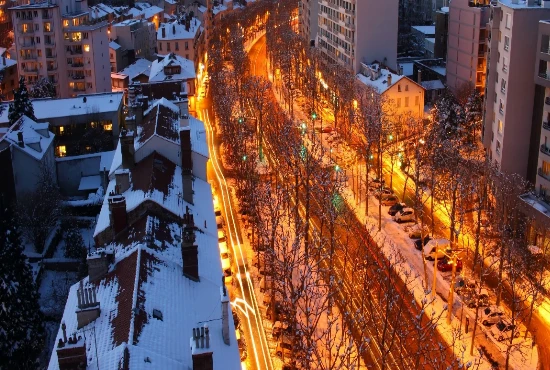

Leave a Reply